Over one billion euro has been invested in the wellness and spa industry in Bulgaria over the past more...
| Search | Hotels / Accommodation | Vacations | Tours & Trips | Rent A Car | Transport | Flights | Conferences | Press Centre | Yachting |
- Hotels & Accommodation in Vidin



- Anna Kristina
- Avramov Hotel
- Dunav hotel
- Neptun Hotel
- The Old Town
- Vidin Hotel
- Nearby hotels



- Danubia Beach Hotel
- Vidin Guide
- Early booking in Vidin
- All inclusive in Vidin
- Last minute in Vidin
- Hotels in Vidin
- Apartments in Vidin
- Villas in Vidin
- Rural houses in Vidin
- Vacations in Vidin
- Transport To Vidin
- Tours in Vidin
- Conferences in Vidin
- Articles on Vidin
- News From Vidin
- Baba Vida Fortress
- Magura Cave
- The Rabisha lake
- Holidays in Bulgaria
- All inclusive
- Beach
- Birdwatching
- Golf
- Health
- History
- Hunting
- Monasteries/ Religious
- Mountain biking
- Prom
- Rural
- Ski
- Spa & Wellness
- Trekking
- Water sports
- Weekend breaks
- Wine
- Conference
- Children Holidays
- Yachting
- Events
- Type of accommodation
- Hotels
- Apartments
- Villas
- Rural houses
- Destinations
- Aheloy
- Ahtopol
- Albena
- Apriltsi
- Arbanassi
- Asparuhovo
- Assenovgrad
- Bachkovo Monastery
- Balchik
- Bankya
- Bansko
- Banya (Karlovo)
- Banya (Razlog)
- Batak
- Beklemeto
- Belchin Bani
- Beli Iskar
- Belogradchik
- Berkovitsa
- Blagoevgrad
- Bodrost
- Bojichen
- Borovets
- Botevgrad
- Bourgas
- Bozhentsi
- Bratsigovo
- Brestovitsa
- Buzludja
- Byala
- Chepelare
- Cherepish Monastery
- Chernomorets
- Chiflik
- Devin
- Dimitrovgrad
- Dobarsko
- Dobrich
- Dobrinishte
- Dolna Banya
- Dospat
- Dryanovo
- Dupnitsa
- Dyuni
- Elena
- Elenite
- Elhovo
- Gabrovo
- Gela
- Golden Sands
- Gorna Oryahovitsa
- Gotse Delchev
- Govedartsi
- Grand Hotel Varna
- Harmanli
- Haskovo
- Haskovo Mineral Baths
- Hissarya
- Ivaylovgrad
- Kalofer
- Kamchia
- Kamen Bryag
- Kardjali
- Karlovo
- Kavarna
- Kazanlak
- Kiten
- Kom
- Koprivshtitsa
- Kosharitsa
- Kostenets
- Kostenkovtsi
- Kotel
- Kovatchevitsa
- Kranevo
- Kresna
- Kulinoto
- Kyustendil
- Lom
- Lovech
- Lozenets
- Lukovit
- Lyaskovets
- Madara
- Malko Tarnovo
- Malyovitsa
- Melnik
- Mezdra
- Momchilovtsi
- Montana
- Narechen Baths
- Near Golden Sands
- Nessebar
- Obzor
- Ognyanovo
- Osogovo
- Pamporovo
- Panagyurishte
- Panichishte
- Parshevitsa
- Pavel Banya
- Pavlikeni
- Pazardjik
- Pernik
- Petrich
- Pirdop
- Pleven
- Pliska
- Plovdiv
- Pomorie
- Pravets
- Preslav
- Primorsko
- Ravda
- Razgrad
- Razlog
- Ribaritsa
- Rila Monastery
- Riviera
- Rousse
- Rusalka
- Samokov
- Sandanski
- Sapareva Banya
- Semkovo
- Sevlievo
- Shabla
- Shipka
- Shipkovo
- Shiroka Laka
- Shkorpilovtsi
- Shoumen
- Silistra
- Sinemorets
- Sliven
- Smolyan
- Sofia
- Sopot
- Sozopol
- Srebarna
- St. Constantine & Elena
- Stara Zagora
- Starozagorski Baths
- Sunny Beach
- Sunny Day
- Sveti Vlas
- Svilengrad
- Svishtov
- Targovishte
- Teteven
- Tran
- Trigrad
- Troyan
- Tryavna
- Tsarevo
- Tsigov Chark
- Uzana
- Varna
- Varshets
- Veliko Tarnovo
- Velingrad
- Vidin
- Vitosha
- Voneshta Voda
- Vratsa
- Vratsata Gorge
- Yagoda
- Yakoruda
- Yambol
- Zlatitsa
- Zlatograd
- Bulgaria Guide
- General information
- Bulgarian Monasteries
- SPA Bulgaria
- The Black sea
- History
- Geography
- Maps
- Weather
- Airports in Bulgaria
- Webcams
- Forums
- Mountains in Bulgaria
- The Balkan Mountain Range
- Rila Mountain
- Pirin Mountain
- The Rodope Mountain
- Vitosha Mountain
- Travel Arrangements
- Visit Bulgaria
- Visa Requierments
- Choose Destination
- Flights to Bulgaria
- Transport in Bulgaria
- Advice
- Currency
- Official Holidays
Subscribe to newsletters to receive our hottest offers:
| Home > Vidin > News |
The Magura cave exhibits 8000 year old drawings
bnr.bg, Veneta Nikolova, Radostin Zhelev
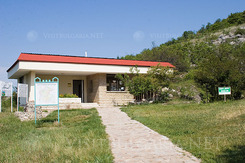
Only 17 km away from the town of Belogradchik in Northwestern Bulgaria lies one of Bulgaria’s nature wonders, the Magura cave. The site that resembles an underground cathedral with its exquisite rock embroidery and the weird-shaped stalactites and stalagmites has become unique with the ancient drawings that decorate its walls. The oldest among those date back 8000 years and have been preserved in an excellent state. These exemplary specimens of prehistoric art tend also to be among the earliest in Europe. They are nowhere else in Bulgaria to be found. Similar drawings have been discovered in France, Italy and Spain.
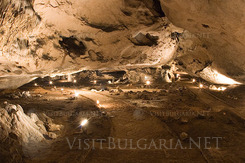 The Magura cave is among the most frequently visited tourist sites in Northwestern Bulgaria. It is also one of Bulgaria’s largest caves with a total length of nearly 3 km. It is equipped with the respective flights of stairs, observation grounds, banisters, etc, that make it easily accessible to tourists. It will take you at least an hour and 40 minutes to complete the guided tour of the cave. However, the walk involves a great deal of passing through tiny fissures and tunnels that unite the various galleries. The breathtaking beauty of nature’s wonders will reveal the exquisite stalactites and stalagmites beautifully lit by the footlights that assume the shape of human beings, animals and mythical monsters and that fill the cave with their extraordinary presence.
The Magura cave is among the most frequently visited tourist sites in Northwestern Bulgaria. It is also one of Bulgaria’s largest caves with a total length of nearly 3 km. It is equipped with the respective flights of stairs, observation grounds, banisters, etc, that make it easily accessible to tourists. It will take you at least an hour and 40 minutes to complete the guided tour of the cave. However, the walk involves a great deal of passing through tiny fissures and tunnels that unite the various galleries. The breathtaking beauty of nature’s wonders will reveal the exquisite stalactites and stalagmites beautifully lit by the footlights that assume the shape of human beings, animals and mythical monsters and that fill the cave with their extraordinary presence.
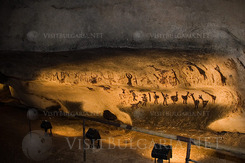 The largest cave formation protruding from
The largest cave formation protruding from
the floor to the ceiling is nearly 20 m tall, and the diameter at its base is 4 m. Another attraction is the so-called “Fallen Pine Tree”. With its 11 m in height and 6 m in width it holds the record of being the largest stalagmite of all in Bulgaria’s explored caves. The bat is the master of the place. It inhabits the cave alongside non-vertebrae species. Archaeologists have unearthed remains from a cave bear, wild horse and cave hyena the three of them of a size that is impressive compared to that of the contemporary animals. These species long gone from the face of the earth have been contemporaries of primitive man, who used to dwell deep into the cave for several millennia.
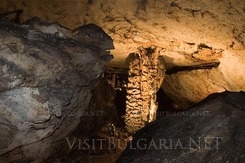 “The first traces of human presence here date back 8000 years B.C.,” cave guide Vanyo Ranghelov says. “Humans used to inhabit the cave until the early Bronze Age. Remains of primitive man abodes have been dug out in the largest cave hall, The Hall of Triumph. Visitors can see wooden sticks stuck into the ground at a distance of 25 m from one another. The sticks have been intertwined with staffs and plastered up with clay and straw. Each abode had its own furnace used not only for roasting meat, but also for annealing pottery, fragments of which were discovered at the site. Another peculiar find are the ancient tools made of flint, stone and deer horns. Those included among others two stone blocks that were used to grind the grain until it became flour.”
“The first traces of human presence here date back 8000 years B.C.,” cave guide Vanyo Ranghelov says. “Humans used to inhabit the cave until the early Bronze Age. Remains of primitive man abodes have been dug out in the largest cave hall, The Hall of Triumph. Visitors can see wooden sticks stuck into the ground at a distance of 25 m from one another. The sticks have been intertwined with staffs and plastered up with clay and straw. Each abode had its own furnace used not only for roasting meat, but also for annealing pottery, fragments of which were discovered at the site. Another peculiar find are the ancient tools made of flint, stone and deer horns. Those included among others two stone blocks that were used to grind the grain until it became flour.”
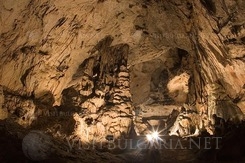 Alongside the primeval instinct for survival and procreation primitive man felt the urge for art and beauty. Their need to communicate with the environment around them mirrored itself in the drawings they left on the cave’s walls. The Abstract compositions represent the everyday life of the primitive people, and their ideas about the frame of the world. Visitors can discern the figures of dancing male and female bodies, hunting men and people wearing masks. The female figures are considerably taller than the male ones because that was the time of their supremacy, Vanyo Ranghelov says.
Alongside the primeval instinct for survival and procreation primitive man felt the urge for art and beauty. Their need to communicate with the environment around them mirrored itself in the drawings they left on the cave’s walls. The Abstract compositions represent the everyday life of the primitive people, and their ideas about the frame of the world. Visitors can discern the figures of dancing male and female bodies, hunting men and people wearing masks. The female figures are considerably taller than the male ones because that was the time of their supremacy, Vanyo Ranghelov says.
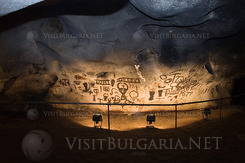 There is also an abundance of images of prehistoric animals and plants. And dominating the scene are the suns and stars. According to scientists, The Solar Calendar drawing is a metaphor of the four seasons. The ancient drawings look so vivid to this day because the primitive artist had used guano paint made of bat feces and rich in phosphorus. And one more thing: the drawings appear three dimensional because the lime around them has eroded, whereas the guano paint has forever encapsulated them.
There is also an abundance of images of prehistoric animals and plants. And dominating the scene are the suns and stars. According to scientists, The Solar Calendar drawing is a metaphor of the four seasons. The ancient drawings look so vivid to this day because the primitive artist had used guano paint made of bat feces and rich in phosphorus. And one more thing: the drawings appear three dimensional because the lime around them has eroded, whereas the guano paint has forever encapsulated them.
See more articles about the Magura cave here:
![]() The Magura cave near Rabisha village in Vidin region, Bulgaria.
The Magura cave near Rabisha village in Vidin region, Bulgaria.
![]() The Rabisha Lake – summer getaway for connoisseurs
The Rabisha Lake – summer getaway for connoisseurs
![]() The Magura cave – mysticism in the womb of earth
The Magura cave – mysticism in the womb of earth


















